Connotation of Schrödinger's cat
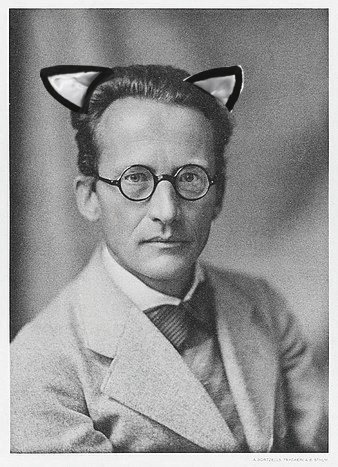
「シュレーディンガーの猫」の含意
Connotation of Schrödinger's cat

シュレディンガーの猫の含意について考え る。まず、ウィキペディア(https://goo.gl/Yqlfji) を資料にシュレディンガーの猫を考える。そのアウトラインには次のように記載されている。
「蓋のある箱を用意して、この中に猫を一匹入れる。箱の中には猫の他に、放射性物質のラジウムを一定量と、ガイガーカウンターを1台、青酸 ガスの発生装置を1台入れておく。もし、箱の中にあるラジウムがアルファ粒子を出すと、これをガイガーカウンターが感知して、その先についた青酸ガスの発 生装置が作動し、青酸ガスを吸った猫は死ぬ。しかし、ラジウムからアルファ粒子が出なければ、青酸ガスの発生装置は作動せず、猫は生き残る。一定時間経過 後、果たして猫は生きているか死んでいるか。
この系において、猫の生死はアルファ粒子が出たかどうかのみにより決定すると仮定する。そして、アルファ粒子は原子核のアルファ崩壊にとも なって放出される。このとき、例えば箱に入れたラジウムが1時間以内にアルファ崩壊してアルファ粒子が放出される確率は50 %だとする。この箱の蓋を閉めてから1時間後に蓋を開けて観測したとき、猫が生きている確率は50 %、死んでいる確率も50 %である。したがって、この猫は、生きている状態と死んでいる状態が1:1で重なりあっていると解釈しなければならない。
我々は経験上、猫が生きている状態と猫が死んでいる状態という二つの状態を認識することができるが、このような重なりあった状態を認識する
ことはない。これが科学的に大きな問題となるのは、たとえ実際に妥当な手法を用いて実験を行ったとしても、観測して得られた実験結果は既に出た結果であ
り、本当に知りたいことである観測の影響を受ける前の状態ではないため、実験結果そのものには意味がなく、検証のしようがないということである」https://goo.gl/Yqlfji
その歴史的背景とは……
「この思考実験は、(「波動関数の収縮」が、人間の「意識」によるものとした)「ノイマン-ウィグナー理論」に対する批判として、シュレー ディンガー()によって提出された[1]。まず、量子力学の確率解釈を容易な方法で巨視的な実験系にすることができることを示し、そこから得られる結論の 異常 さを示して批判したのである。シュレーディンガーは、これをパラドックスと呼んだ。現在では「シュレーディンガーの猫」のような巨視的に量子力学の効果が 現れる実験系が知られており、「シュレーディンガーの猫」は量子力学が引き起こす奇妙な現象を説明する際の例示に用いられる」https://goo.gl/Yqlfji
しかし、これは、ディビッド・ヒュームの 因果説批判を、パロディ的に捩って、かつ、(伝統的な哲学的な議論としては)完全にスベったもののよう に思える(→「むかし懐疑論、いま量子論」)。
シュレーディンガーの猫( Schrödinger's cat):猫、毒の小瓶、 ガイガーカウンターに接続された放射性源が密閉された箱に入れられている。図示されているように、量子論では、生きている猫と死んだ猫の重ね合わせが用い られる。
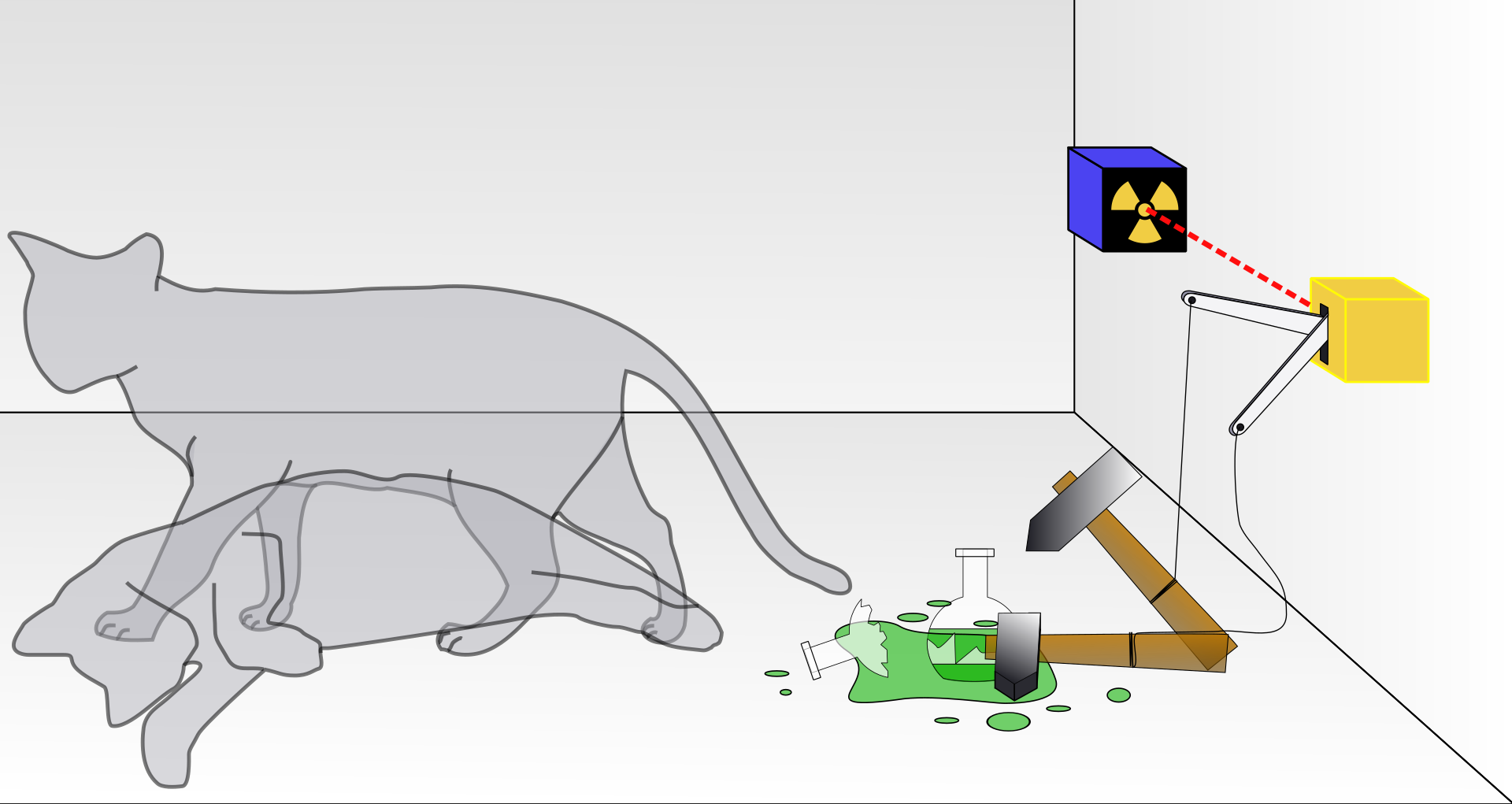 Schrödinger's cat: a cat, a flask of poison, and a radioactive source connected to a Geiger counter are placed in a sealed box. As illustrated, the quantum description uses a superposition of an alive cat and one that has died. |
 シュレーディンガーの猫:猫、毒の小瓶、ガイガーカウンターに接続され た放射性源が密閉された箱に入れられている。図示されているように、量子論では、生きている猫と死んだ猫の重ね合わせが用いられる。 |
| In quantum mechanics,
Schrödinger's cat is a thought experiment concerning quantum
superposition. In the thought experiment, a hypothetical cat may be
considered simultaneously both alive and dead, while it is unobserved
in a closed box, as a result of its fate being linked to a random
subatomic event that may or may not occur. This experiment viewed this
way is described as a paradox. This thought experiment was devised by
physicist Erwin Schrödinger in 1935[1] in a discussion with Albert
Einstein[2] to illustrate what Schrödinger saw as the problems of the
Copenhagen interpretation of quantum mechanics. In Schrödinger's original formulation, a cat, a flask of poison, and a radioactive source are placed in a sealed box. If an internal radiation monitor (e.g. a Geiger counter) detects radioactivity (i.e. a single atom decaying), the flask is shattered, releasing the poison, which kills the cat. The Copenhagen interpretation implies that, after a while, the cat is simultaneously alive and dead. Yet, when one looks in the box, one sees the cat either alive or dead, not both alive and dead. This poses the question of when exactly quantum superposition ends and reality resolves into one possibility or the other. Although originally a critique on the Copenhagen interpretation, Schrödinger's seemingly paradoxical thought experiment became part of the foundation of quantum mechanics. The scenario is often featured in theoretical discussions of the interpretations of quantum mechanics, particularly in situations involving the measurement problem. As a result, Schrödinger's cat has had enduring appeal in popular culture. The experiment is not intended to be actually performed on a cat, but rather as an easily understandable illustration of the behavior of atoms. Experiments at the atomic scale have been carried out, showing that very small objects may exist as superpositions; but superposing an object as large as a cat would pose considerable technical difficulties.[citation needed] Fundamentally, the Schrödinger's cat experiment asks how long quantum superpositions last and when (or whether) they collapse. Different interpretations of the mathematics of quantum mechanics have been proposed that give different explanations for this process. |
量子力学において、シュレーディンガーの猫とは量子重ね合わせに関する
思考実験である。この思考実験では、仮説上の猫が、閉ざされた箱の中で観察されていないにもかかわらず、同時に生きているとも死んでいるとも考えられる。
これは、その運命が、発生するかもしれないし発生しないかもしれないランダムな素粒子の事象と結びついているためである。このように考えられたこの実験
は、パラドックスとして説明される。この思考実験は、1935年に物理学者エルヴィン・シュレーディンガーが、アルベルト・アインシュタインとの議論の中
で考案したものであり[1]、シュレーディンガーがコペンハーゲン解釈の量子力学の問題点として捉えていたことを説明するために考案されたものである。 シュレディンガーのオリジナルの定式化では、猫、毒の小瓶、放射性物質が密閉された箱の中に入れられる。 内部放射線モニター(例えばガイガーカウンター)が放射能を検知すると(つまり、1つの原子が崩壊すると)、小瓶が粉々に砕け、毒が放出され、猫が死ぬ。 コペンハーゲン解釈では、しばらくすると猫は同時に生きていると同時に死んでいることになる。しかし、箱の中を覗くと、猫は生きているか死んでいるかのど ちらかであり、生きていると同時に死んでいるわけではない。このことは、量子重ね合わせがいつ正確に終わり、現実が一方の可能性に収束するのかという疑問 を提起する。 もともとはコペンハーゲン解釈に対する批判であったが、シュレーディンガーのこの一見パラドキシカルな思考実験は、量子力学の基礎の一部となった。このシ ナリオは、特に測定問題を伴う状況において、量子力学の解釈に関する理論的な議論でよく取り上げられる。その結果、シュレーディンガーの猫は大衆文化にお いて根強い人気を保っている。この実験は猫に対して実際に実施することを目的としたものではなく、原子の挙動をわかりやすく説明するためのものである。原 子レベルの実験は行われており、非常に小さな物体は重ね合わせ状態で存在しうることを示しているが、猫ほどの大きさの物体を重ね合わせることは技術的に非 常に困難である。 シュレーディンガーの猫の実験は、基本的に、量子重ね合わせがどのくらいの時間続くのか、いつ(あるいは重ね合わせが崩壊するのか)を問うものである。量 子力学の数学に対するさまざまな解釈が提案されており、このプロセスに対するさまざまな説明がなされている。 |
| Origin and motivation Unsolved problem in physics: How does the quantum description of reality, which includes elements such as the superposition of states and wavefunction collapse or quantum decoherence, give rise to the reality we perceive? Another way of stating this question regards the measurement problem: What constitutes a "measurement" that apparently causes the wave function to collapse into a definite state? (more unsolved problems in physics) Schrödinger intended his thought experiment as a discussion of the EPR article—named after its authors Einstein, Podolsky, and Rosen—in 1935.[3][4] The EPR article highlighted the counterintuitive nature of quantum superpositions, in which a quantum system for two particles does not separate[5]: 150 even when the particles are detected far from their last point of contact. The EPR paper concludes with a claim that this lack of separability meant that quantum mechanics as a theory of reality was incomplete. Schrödinger and Einstein exchanged letters about Einstein's EPR article, in the course of which Einstein pointed out that the state of an unstable keg of gunpowder will, after a while, contain a superposition of both exploded and unexploded states.[4] To further illustrate, Schrödinger described how one could, in principle, create a superposition in a large-scale system by making it dependent on a quantum particle that was in a superposition. He proposed a scenario with a cat in a closed steel chamber, wherein the cat's life or death depended on the state of a radioactive atom, whether it had decayed and emitted radiation or not. According to Schrödinger, the Copenhagen interpretation implies that the cat remains both alive and dead until the state has been observed. Schrödinger did not wish to promote the idea of dead-and-live cats as a serious possibility; on the contrary, he intended the example to illustrate the absurdity of the existing view of quantum mechanics,[1] and thus he was employing reductio ad absurdum. Since Schrödinger's time, various interpretations of the mathematics of quantum mechanics have been advanced by physicists, some of which regard the "alive and dead" cat superposition as quite real, others do not.[6][7] Intended as a critique of the Copenhagen interpretation (the prevailing orthodoxy in 1935), the Schrödinger's cat thought experiment remains a touchstone for modern interpretations of quantum mechanics and can be used to illustrate and compare their strengths and weaknesses.[8] |
起源と動機 物理学における未解決問題: 状態の重ね合わせや波動関数の収縮、量子デコヒーレンスなどの要素を含む現実の量子論的記述は、どのようにして我々が知覚する現実を生み出すのか? この問題を別の観点から表現すると、測定問題となる。波動関数が特定の状態に収縮する原因となる「測定」とは何なのか? (物理学における未解決問題の詳細) シュレーディンガーは、1935年のEPR論文(著者のアインシュタイン、ポドルスキー、ローゼンの名前にちなんで名付けられた)の議論として、この思考 実験を意図していた。[3][4] EPR論文では、量子重ね合わせの直観に反する性質が強調されており、2つの粒子の量子系は分離しない[5]。粒子が最後に接触した地点から離れた場所で 検出された場合でも、150: EPR論文は、この分離不能性は現実の理論としての量子力学が不完全であることを意味するという主張で締めくくられている。 シュレディンガーとアインシュタインは、アインシュタインのEPR論文について手紙のやり取りを行い、その中でアインシュタインは、不安定な火薬樽の状態 は、しばらくすると、爆発した状態と爆発していない状態の両方の重ね合わせを含むことになる、と指摘した。 さらに説明すると、シュレーディンガーは、重ね合わせの状態にある量子粒子に依存させることで、大規模なシステムにおいて重ね合わせの状態を作り出すこと ができることを原理的に説明した。彼は、閉鎖された鉄製の容器に入れられた猫のシナリオを提案した。その猫の生死は、放射性原子の状態、すなわち、崩壊し て放射線を放出しているか否かによって決まる。シュレーディンガーによると、コペンハーゲン解釈では、状態が観測されるまでは猫は生きているとも死んでい るともつかない状態にあるという。シュレーディンガーは、死んでいるのに生きている猫という考えを真剣に可能性として推進しようとしたわけではない。それ どころか、彼はその例を挙げて、量子力学の既存の見解の不合理性を説明しようとしたのである。 シュレディンガーの時代以降、量子力学の数学に関するさまざまな解釈が物理学者たちによって提示されてきたが、その中には「生きている猫」と「死んでいる 猫」の重ね合わせを極めて現実的なものとみなすものもあれば、そうでないものもある。コペンハーゲン解釈(1935年当時の主流の正統派)に対する批判と して考案されたシュレーディンガーの猫の思考実験は、現代の量子力学の解釈の試金石であり続け、その長所と短所を説明し比較するのに使用することができ る。[8] |
Thought experiment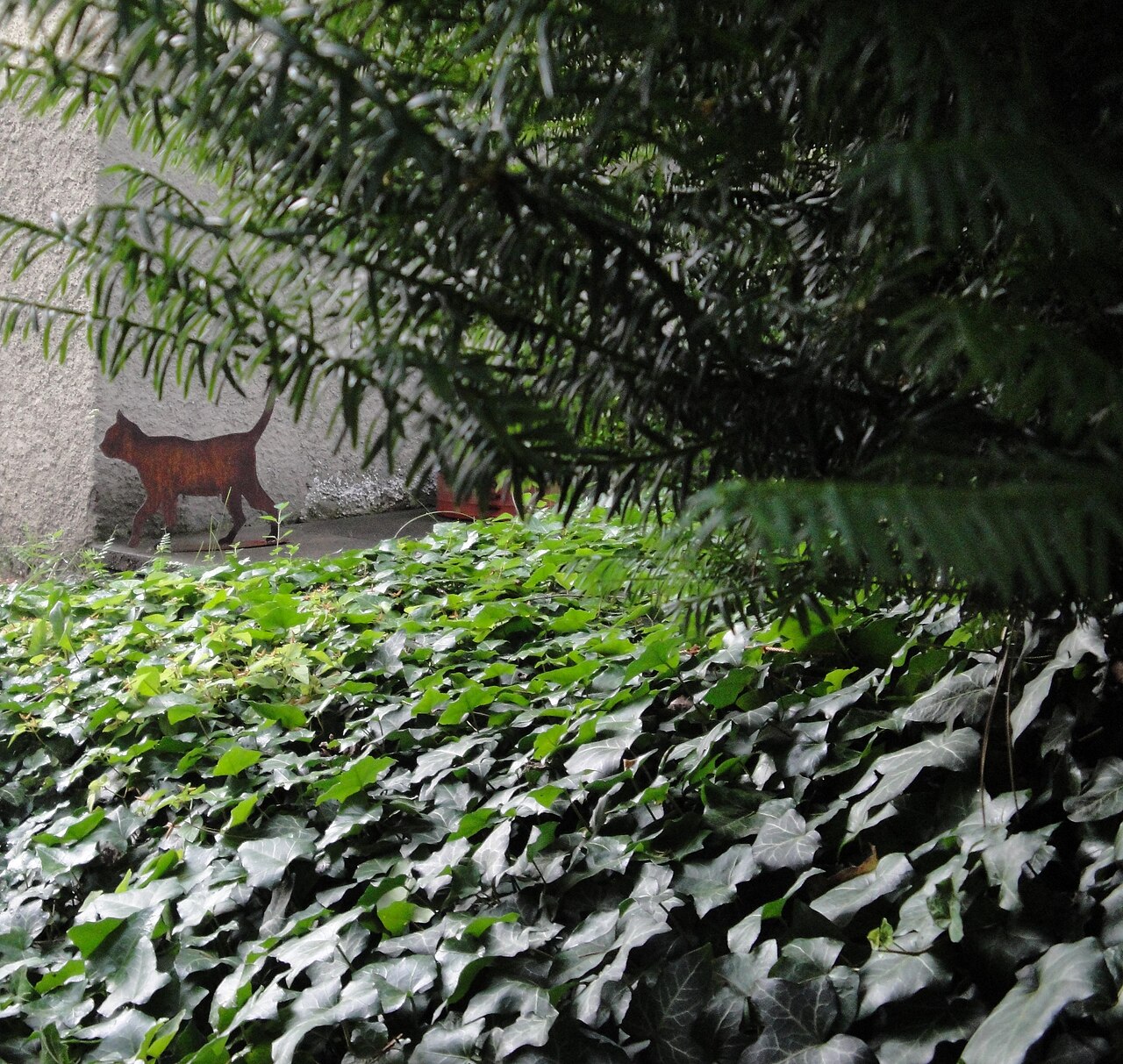 A life-size cat figure in the garden of Huttenstrasse 9, Zurich, where Erwin Schrödinger lived from 1921 to 1926. Depending on the light conditions, the figure appears to be either a live cat or a dead one. Schrödinger wrote:[1][9] One can contrive even completely burlesque [farcical] cases. A cat is put in a steel chamber along with the following infernal device (which must be secured against direct interference by the cat): in a Geiger counter, there is a tiny amount of radioactive substance, so tiny that in the course of an hour one of the atoms will perhaps decay, but also, with equal probability, that none of them will; if it does happen, the counter tube will discharge and through a relay release a hammer that will shatter a small flask of hydrocyanic acid. If one has left this entire system to itself for an hour, one would tell oneself that the cat is still alive if no atom has decayed in the meantime. Even a single atomic decay would have poisoned it. The psi-function of the entire system would express this by having in it the living and dead cat (pardon the expression) mixed or spread out in equal parts. It is typical of these cases that an indeterminacy originally restricted to the atomic domain turns into a sensually observable [macroscopic] indeterminacy, which can then be resolved by direct observation. This prevents us from so naïvely accepting a "blurred model" as representative of reality. Per se, it would not embody anything unclear or contradictory. There is a difference between a shaky or out-of-focus photograph and a snapshot of clouds and fog banks. Schrödinger developed his famous thought experiment in correspondence with Einstein. He suggested this 'quite ridiculous case' to illustrate his conclusion that the wave function cannot represent reality.[5]: 153 The wave function description of the complete cat system implies that the reality of the cat mixes the living and dead cat.[5]: 154 Einstein was impressed by the ability of the thought experiment to highlight these issues. In a letter to Schrödinger dated 1950, he wrote:[5]: 157 You are the only contemporary physicist, besides Laue, who sees that one cannot get around the assumption of reality, if only one is honest. Most of them simply do not see what sort of risky game they are playing with reality—reality as something independent of what is experimentally established. Their interpretation is, however, refuted most elegantly by your system of radioactive atom + amplifier + charge of gun powder + cat in a box, in which the psi-function of the system contains both the cat alive and blown to bits. Nobody really doubts that the presence or absence of the cat is something independent of the act of observation.[10] Note that the charge of gunpowder is not mentioned in Schrödinger's setup, which uses a Geiger counter as an amplifier and hydrocyanic poison instead of gunpowder. The gunpowder had been mentioned in Einstein's original suggestion to Schrödinger 15 years before, and Einstein carried it forward to the present discussion.[4] |
思考実験 1921年から1926年までシュレーディンガーが住んでいたチューリッヒのフッテン通り9番地の庭にある等身大の猫の像。光の状態によって、この像は生 きている猫にも死んだ猫にも見える。 シュレーディンガーは次のように書いている。[1][9] 完全に茶番的な(滑稽な)事例さえも作り出すことができる。猫を次の地獄の装置(猫による直接的な干渉を防ぐ必要がある)とともに鋼鉄製の容器に入れる。 ガイガーカウンターには微量の放射性物質が入っており、その量は1時間で 1時間のうちに原子の1つが崩壊するかもしれないが、同等の確率でどれも崩壊しない可能性もある。もし崩壊が起こると、カウンターのチューブが放電し、リ レーを通してハンマーが解放され、青酸の小瓶を粉砕する。もしこのシステム全体を1時間放置した場合、その間に原子が1つも崩壊していなければ、猫はまだ 生きていると自分自身に言い聞かせるだろう。たとえ1つの原子が崩壊しただけでも、猫は死んでしまう。このシステム全体のサイ機能は、生きている猫と死ん だ猫(表現は悪いが)が混ざり合ったり、同じ割合で広がったりすることで、これを表現するだろう。 原子レベルで当初限定されていた不確定性が、感覚的に観察可能な[巨視的な]不確定性へと変化し、直接観察によって解決できるというケースは、こうした事 例の典型である。このため、私たちは「ぼやけたモデル」を現実の代表として安易に受け入れることはできない。それ自体は、不明瞭なことや矛盾したことを体 現するものではない。手ぶれやピンボケの写真と、雲や霧の群れの写真には違いがある。 シュレーディンガーは、アインシュタインとのやり取りの中で、有名な思考実験を考案した。彼は、波動関数が現実を表すことはできないという結論を説明する ために、この「極めてばかげた事例」を提示した。[5]:153 完全な猫の系に関する波動関数の記述は、猫の現実が生きている猫と死んでいる猫を混ぜ合わせていることを暗示している。[5]:154 アインシュタインは、思考実験がこれらの問題を浮き彫りにする能力に感銘を受けた。1950年のシュレディンガー宛ての手紙で、彼は次のように書いてい る。[5]: 157 あなたはラウエを除けば、正直に考えれば現実の想定を回避できないと理解している唯一の同時代の物理学者である。彼らの大半は、実験的に確立されたものと は独立したものとしての現実というものを、どのような危険なゲームに晒しているのかを理解していない。しかし、彼らの解釈は、シュレディンガーの「放射性 原子+増幅器+火薬の電荷+箱の中の猫」というシステムによって、最もエレガントに否定されている。このシステムにおけるサイの機能には、生きている猫と 粉々になった猫の両方が含まれている。猫の存在や不在が観察行為とは独立したものであることを疑う人はいない。 シュレディンガーの装置では、火薬の装薬については言及されていないことに注意すべきである。シュレディンガーは、ガイガーカウンターをアンプとして使用 し、火薬の代わりに青酸カリを使用した。火薬については、15年前にアインシュタインがシュレディンガーに提案した際に言及されており、アインシュタイン はそれを現在の議論に持ち込んだのである。 |
| Analysis In modern terms Schrodinger's hypothetical cat experiment describes the measurement problem: quantum theory describes the cat system as a combination of two possible outcomes but only one outcome is ever observed.[11]: 57 [12]: 1269 The experiment poses the question, "when does a quantum system stop existing as a superposition of states and become one or the other?" (More technically, when does the actual quantum state stop being a non-trivial linear combination of states, each of which resembles different classical states, and instead begin to have a unique classical description?) Standard microscopic quantum mechanics describes multiple possible outcomes of experiments but only one outcome is observed. The thought experiment illustrates this apparent paradox. Our intuition says that the cat cannot be in more than one state simultaneously—yet the quantum mechanical description of the thought experiment requires such a condition. |
分析 現代的な用語でシュレディンガーの仮説上の猫の実験を説明すると、測定問題となる。量子論では、猫のシステムを2つの可能な結果の組み合わせとして記述す るが、実際に観測されるのは1つの結果のみである。[11]: 57 [12]: 1269 この実験では、「量子システムはいつ重ね合わせの状態として存在しなくなり、どちらか一方の状態になるのか?」という疑問が提起される。(より専門的に言 えば、実際の量子状態が、それぞれ異なる古典状態に似た状態の、非自明な線形結合でなくなるのはいつか、そして代わりに、唯一の古典的記述を持つようにな るのはいつか?)標準的な微視的量子力学では、実験の複数の可能な結果が説明されるが、観測されるのは1つの結果のみである。思考実験は、この一見したと ころのパラドックスを明らかにする。私たちの直感では、猫が同時に複数の状態にあることはありえない。しかし、思考実験の量子力学的な説明では、そのよう な条件が必要となる。 |
| Interpretations Since Schrödinger's time, other interpretations of quantum mechanics have been proposed that give different answers to the questions posed by Schrödinger's cat of how long superpositions last and when (or whether) they collapse. Copenhagen interpretation Main article: Copenhagen interpretation A commonly held interpretation of quantum mechanics is the Copenhagen interpretation.[13] In the Copenhagen interpretation, a measurement results in only one state of a superposition. This thought experiment makes apparent the fact that this interpretation simply provides no explanation for the state of the cat while the box is closed. The wavefunction description of the system consists of a superposition of the states "decayed nucleus/dead cat" and "undecayed nucleus/living cat". Only when the box is opened and observed can we make a statement about the cat.[5]: 157 Von Neumann interpretation Main article: Von Neumann–Wigner interpretation In 1932, John von Neumann described in his book Mathematical Foundations a pattern where the radioactive source is observed by a device, which itself is observed by another device and so on. It makes no difference in the predictions of quantum theory where along this chain of causal effects the superposition collapses.[14] This potentially infinite chain could be broken if the last device is replaced by a conscious observer. This solved the problem because it was claimed that an individual's consciousness cannot be multiple.[15] Neumann asserted that a conscious observer is necessary for a collapse to one or the other (e.g., either a live cat or a dead cat) of the terms on the right-hand side of a wave function. This interpretation was later adopted by Eugene Wigner, who then rejected the interpretation in a thought experiment known as Wigner's friend.[16] Wigner supposed that a friend opened the box and observed the cat without telling anyone. From Wigner's conscious perspective, the friend is now part of the wave function and has seen a live cat and seen a dead cat. To a third person's conscious perspective, Wigner himself becomes part of the wave function once Wigner learns the outcome from the friend. This could be extended indefinitely.[16] A resolution of the paradox is that the triggering of the Geiger counter counts as a measurement of the state of the radioactive substance. Because a measurement has already occurred deciding the state of the cat, the subsequent observation by a human records only what has already occurred.[17] Analysis of an actual experiment by Roger Carpenter and A. J. Anderson found that measurement alone (for example by a Geiger counter) is sufficient to collapse a quantum wave function before any human knows of the result.[18] The apparatus indicates one of two colors depending on the outcome. The human observer sees which color is indicated, but they don't consciously know which outcome the color represents. A second human, the one who set up the apparatus, is told of the color and becomes conscious of the outcome, and the box is opened to check if the outcome matches.[14] However, it is disputed whether merely observing the color counts as a conscious observation of the outcome.[19] Bohr's interpretation Analysis of the work of Niels Bohr, one of the main scientists associated with the Copenhagen interpretation, suggests he viewed the state of the cat before the box is opened as indeterminate. The superposition itself had no physical meaning to Bohr: Schrödinger's cat would be either dead or alive long before the box is opened but the cat and box form a inseparable combination.[20] Bohr saw no role for a human observer.[21]: 35 Bohr emphasized the classical nature of measurement results. An "irreversible" or effectively irreversible process imparts the classical behavior of "observation" or "measurement".[22][23][24] Many-worlds interpretation Main article: Many-worlds interpretation 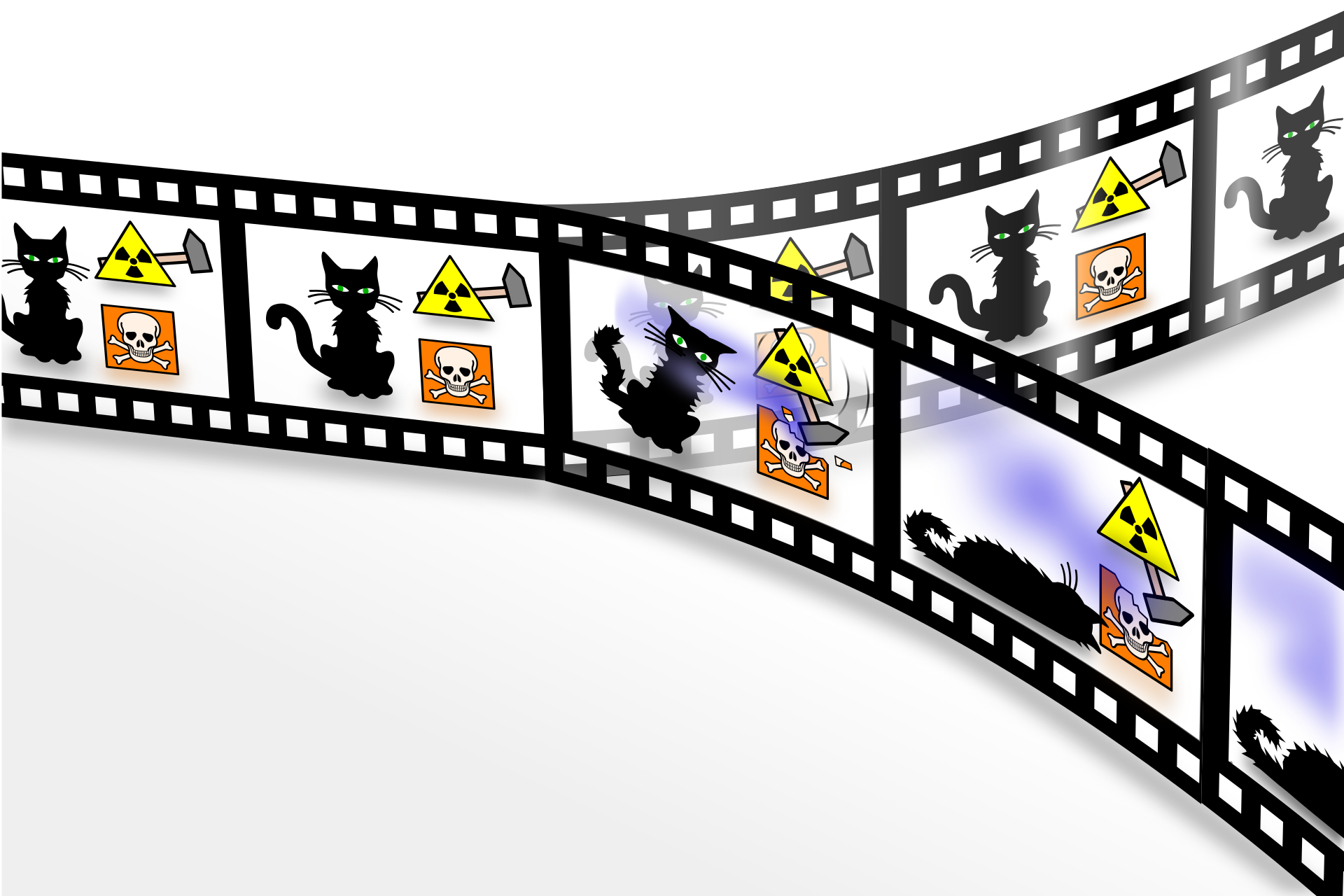 The quantum-mechanical "Schrödinger's cat" paradox according to the many-worlds interpretation. In this interpretation, every event is a branch point. The cat is both alive and dead—regardless of whether the box is opened—but the "alive" and "dead" cats are in different branches of the universe that are equally real but cannot interact with each other. In 1957, Hugh Everett formulated the many-worlds interpretation of quantum mechanics, which does not single out observation as a special process. In the many-worlds interpretation, both alive and dead states of the cat persist after the box is opened, but are decoherent from each other. In other words, when the box is opened, the observer and the possibly-dead cat split into an observer looking at a box with a dead cat and an observer looking at a box with a live cat. But since the dead and alive states are decoherent, there is no communication or interaction between them. When opening the box, the observer becomes entangled with the cat, so "observer states" corresponding to the cat's being alive and dead are formed; each observer state is entangled, or linked, with the cat so that the observation of the cat's state and the cat's state correspond with each other. Quantum decoherence ensures that the different outcomes have no interaction with each other. Decoherence is generally considered to prevent simultaneous observation of multiple states.[25][26] A variant of the Schrödinger's cat experiment, known as the quantum suicide machine, has been proposed by cosmologist Max Tegmark. It examines the Schrödinger's cat experiment from the point of view of the cat, and argues that by using this approach, one may be able to distinguish between the Copenhagen interpretation and many-worlds. Ensemble interpretation The ensemble interpretation states that superpositions are nothing but subensembles of a larger statistical ensemble. The state vector would not apply to individual cat experiments, but only to the statistics of many similarly prepared cat experiments. Proponents of this interpretation state that this makes the Schrödinger's cat paradox a trivial matter, or a non-issue. This interpretation serves to discard the idea that a single physical system in quantum mechanics has a mathematical description that corresponds to it in any way.[27] Relational interpretation Main article: Relational quantum mechanics The relational interpretation makes no fundamental distinction between the human experimenter, the cat, and the apparatus or between animate and inanimate systems; all are quantum systems governed by the same rules of wavefunction evolution, and all may be considered "observers". But the relational interpretation allows that different observers can give different accounts of the same series of events, depending on the information they have about the system.[28] The cat can be considered an observer of the apparatus; meanwhile, the experimenter can be considered another observer of the system in the box (the cat plus the apparatus). Before the box is opened, the cat, by nature of its being alive or dead, has information about the state of the apparatus (the atom has either decayed or not decayed); but the experimenter does not have information about the state of the box contents. In this way, the two observers simultaneously have different accounts of the situation: To the cat, the wavefunction of the apparatus has appeared to "collapse"; to the experimenter, the contents of the box appear to be in superposition. Not until the box is opened, and both observers have the same information about what happened, do both system states appear to "collapse" into the same definite result, a cat that is either alive or dead. Transactional interpretation In the transactional interpretation the apparatus emits an advanced wave backward in time, which combined with the wave that the source emits forward in time, forms a standing wave. The waves are seen as physically real, and the apparatus is considered an "observer". In the transactional interpretation, the collapse of the wavefunction is "atemporal" and occurs along the whole transaction between the source and the apparatus. The cat is never in superposition. Rather the cat is only in one state at any particular time, regardless of when the human experimenter looks in the box. The transactional interpretation resolves this quantum paradox.[29] Objective collapse theories According to objective collapse theories, superpositions are destroyed spontaneously (irrespective of external observation) when some objective physical threshold (of time, mass, temperature, irreversibility, etc.) is reached. Thus, the cat would be expected to have settled into a definite state long before the box is opened. This could loosely be phrased as "the cat observes itself" or "the environment observes the cat". Objective collapse theories require a modification of standard quantum mechanics to allow superpositions to be destroyed by the process of time evolution.[30] These theories could ideally be tested by creating mesoscopic superposition states in the experiment. For instance, energy cat states has been proposed as a precise detector of the quantum gravity related energy decoherence models.[31] |
解釈 シュレーディンガーの時代以降、重ね合わせの状態がどのくらいの時間続くのか、いつ(あるいは重ね合わせが崩壊するのか)という「シュレーディンガーの 猫」が提起した疑問に対して、異なる答えを与える量子力学の解釈が提案されている。 コペンハーゲン解釈 詳細は「コペンハーゲン解釈」を参照 量子力学の一般的な解釈は、コペンハーゲン解釈である。[13] コペンハーゲン解釈では、測定の結果、重ね合わせの状態は1つの状態にのみ収束する。この思考実験は、箱が閉じられている間、この解釈では猫の状態につい てまったく説明できないという事実を明らかにしている。この系における波動関数の記述は、「崩壊した原子核/死んだ猫」と「崩壊していない原子核/生きて いる猫」の状態の重ね合わせで構成される。箱が開けられ、観察されたときにのみ、猫の状態について言及することができる。[5]:157 フォン・ノイマン解釈 詳細は「フォン・ノイマン=ウィグナー解釈」を参照 1932年、ジョン・フォン・ノイマンは著書『数学的基礎』の中で、放射性物質が装置によって観測され、その装置自体が別の装置によって観測される、とい うパターンを説明した。この因果関係の連鎖のどこで重ね合わせが崩壊しても、量子論の予測に違いはない。[14] この潜在的に無限の連鎖は、最後の装置が意識を持つ観察者に置き換えられた場合、途切れる可能性がある。なぜなら、個人の意識は複数存在することはありえ ないと主張されているからである。[15] ノイマンは、波動関数の右辺の項がどちらか一方(例えば、生きている猫か死んだ猫)に収縮するには、意識を持つ観察者が必要であると主張した。この解釈は 後にユージン・ウィグナーによって採用されたが、ウィグナーはその後、ウィグナーの友人と呼ばれる思考実験によってこの解釈を否定した。[16] ウィグナーは、友人が箱を開け、誰にも告げずに猫を観察したと仮定した。ウィグナーの意識から見ると、友人は今や波動関数の一部であり、生きた猫と死んだ 猫の両方を見たことになる。第三者の意識から見ると、ウィグナー自身が波動関数の一部となり、ウィグナーが友人から結果を聞いた時点で、ウィグナー自身が 波動関数の一部となる。これは無限に拡張できる。[16] このパラドックスの解決策は、ガイガーカウンターの作動が放射性物質の状態の測定と見なされるというものである。猫の状態を決める測定はすでに起こってい るため、その後の人間による観察は、すでに起こったことだけを記録する。[17] ロジャー・カーペンターとA.J.アンダーソンによる実際の実験の分析では、測定(例えばガイガーカウンターによる)だけで、結果が誰にも知られる前に量 子波動関数を崩壊させるのに十分であることが分かった。[18] 装置は結果に応じて2つのうちの1つの色を示す。人間の観察者はどちらの色が表示されているかを見るが、その色がどちらの結果を表しているかについては意 識的には知らない。2人目の人間、つまり装置をセットアップした人間は、色の情報を伝えられ、結果を意識するようになり、結果が一致しているかを確認する ために箱が開けられる。[14] しかし、色を観察するだけで結果を意識的に観察したことになるかどうかについては議論がある。[19] ボーアの解釈 コペンハーゲン解釈の主要な科学者の一人であるニールス・ボーアの研究の分析によると、彼は箱が開けられる前の猫の状態は不確定であると見ていたことが示 唆されている。重ね合わせそれ自体には、ボーアにとって物理的な意味はなかった。シュレーディンガーの猫は箱が開けられるずっと前に死んでいるか生きてい るかのどちらかになるが、猫と箱は不可分の組み合わせである。[20] ボーアは人間の観察者の役割を認めていなかった。[21]: 35 ボーアは測定結果の古典的な性質を強調した。不可逆的」または事実上不可逆的なプロセスは、「観測」または「測定」の古典的な挙動をもたらす。[22] [23][24] 多世界解釈 詳細は「多世界解釈」を参照  多世界解釈による量子力学の「シュレーディンガーの猫」のパラドックス。この解釈では、あらゆる事象が分岐点となる。箱が開けられるかどうかに関わらず、 猫は生きていると同時に死んでいるが、「生きている」猫と「死んでいる」猫は、等しく現実であるが互いに相互作用できない宇宙の異なる分岐点に存在してい る。 1957年、ヒュー・エヴェレットは、観測を特別なプロセスとして扱わない量子力学の多世界解釈を提唱した。多世界解釈では、箱が開けられた後も、生きて いる状態と死んでいる状態の両方の猫が同時に存在し続けるが、互いに干渉し合わない。つまり、箱が開けられると、観察者と死んでいるかもしれない猫は、死 んだ猫が入っている箱を見ている観察者と、生きている猫が入っている箱を見ている観察者に分かれる。しかし、死んでいる状態と生きている状態はデコヒーレ ントであるため、両者間にはコミュニケーションも相互作用もない。 箱を開けると、観察者は猫と絡み合い、猫が生きていたり死んでいたりする状態に対応する「観察者の状態」が形成される。それぞれの観察者の状態は猫と絡み 合い、あるいはリンクしており、猫の状態の観察と猫の状態が互いに呼応する。量子デコヒーレンスにより、異なる結果が互いに影響し合うことはない。一般的 に、デコヒーレンスは複数の状態の同時観測を妨げると考えられている。[25][26] 量子自殺マシンとして知られる、シュレーディンガーの猫実験の変形が、宇宙学者マックス・テグマークによって提案されている。これは、猫の視点からシュ レーディンガーの猫実験を検証し、このアプローチを用いることで、コペンハーゲン解釈と多世界解釈を区別できる可能性があることを論じている。 アンサンブル解釈 アンサンブル解釈では、重ね合わせはより大きな統計的アンサンブルのサブアンサンブルに他ならないと主張する。状態ベクトルは個々の猫の実験には適用され ず、同様に準備された多数の猫の実験の統計にのみ適用される。この解釈の支持者たちは、この解釈によりシュレーディンガーの猫のパラドックスは些細な問 題、あるいは問題ではないと主張する。 この解釈は、量子力学における単一の物理系が、何らかの形で対応する数学的記述を持つという考えを捨てるのに役立つ。[27] 相関解釈 詳細は「相関量子力学」を参照 相関解釈では、人間の実験者、猫、装置、あるいは生物系と非生物系の間に根本的な区別は存在しない。すべては波動関数の進化に関する同じ規則によって支配 される量子系であり、すべてが「観測者」であるとみなすことができる。しかし、相関的解釈では、異なる観察者は、システムに関する情報に応じて、同じ一連 の出来事について異なる説明を行うことができるとしている。[28] 猫は装置の観察者とみなすことができる。一方、実験者は箱の中のシステム(猫と装置)の別の観察者とみなすことができる。箱が開かれる前、猫は生きている か死んでいるかという性質によって、装置の状態(原子が崩壊したか、崩壊していないか)に関する情報を有しているが、実験者は箱の中身の状態に関する情報 を有していない。このように、2人の観察者は同時に異なる状況を認識している。猫にとっては装置の波動関数が「崩壊」したように見え、実験者にとっては箱 の中身が重ね合わせの状態にあるように見える。箱が開けられ、両方の観察者が何が起こったかについて同じ情報を得るまでは、両方の系状態は同じ明確な結 果、つまり生きているか死んでいるかのどちらかの猫に「崩壊」したように見える。 トランザクション解釈 トランザクション解釈では、装置は時間をさかのぼって進んだ波を放出し、それが源が時間をさかのぼって放出した波と組み合わさって定常波を形成する。波は 物理的に現実のものであると見なされ、装置は「観測者」と見なされる。トランザクション解釈では、波動関数の崩壊は「非時間的」であり、源と装置間のトラ ンザクション全体に沿って発生する。猫は重ね合わせの状態には決してない。むしろ、猫は、人間の実験者が箱の中を覗く時間に関係なく、特定の時間には常に 1つの状態にあるだけである。トランザクション解釈は、この量子パラドックスを解決する。[29] 客観的崩壊理論 客観的崩壊理論によると、客観的な物理的閾値(時間、質量、温度、不可逆性など)に達すると、(外部からの観察とは関係なく)重ね合わせは自然に崩壊す る。したがって、箱が開けられるずっと前に、猫は明確な状態に落ち着いているはずである。これは「猫が自らを観察する」あるいは「環境が猫を観察する」と 大まかに表現できる。 客観的崩壊理論では、時間発展の過程で重ね合わせを破壊できるようにするため、標準的な量子力学の修正が必要である。[30] これらの理論は、実験でメゾスコピックな重ね合わせ状態を作り出すことで理想的に検証できる可能性がある。例えば、エネルギー猫状態は、量子重力に関連す るエネルギーのデコヒーレンスモデルの精密な検出器として提案されている。[31] |
| Applications and tests Duration: 2 minutes and 57 seconds.2:57 Schrödinger's cat quantum superposition of states and effect of the environment through decoherence The experiment as described is a purely theoretical one, and the machine proposed is not known to have been constructed. However, successful experiments involving similar principles, e.g. superpositions of relatively large (by the standards of quantum physics) objects have been performed.[32][better source needed] These experiments do not show that a cat-sized object can be superposed, but the known upper limit on "cat states" has been pushed upwards by them. In many cases the state is short-lived, even when cooled to near absolute zero. A "cat state" has been achieved with photons.[33] A beryllium ion has been trapped in a superposed state.[34] An experiment involving a superconducting quantum interference device ("SQUID") has been linked to the theme of the thought experiment: "The superposition state does not correspond to a billion electrons flowing one way and a billion others flowing the other way. Superconducting electrons move en masse. All the superconducting electrons in the SQUID flow both ways around the loop at once when they are in the Schrödinger's cat state."[35] A piezoelectric "tuning fork" has been constructed, which can be placed into a superposition of vibrating and non vibrating states. The resonator comprises about 10 trillion atoms.[36] An experiment involving a flu virus has been proposed.[37] An experiment involving a bacterium and an electromechanical oscillator has been proposed.[38] In quantum computing the phrase "cat state" sometimes refers to the GHZ state, wherein several qubits are in an equal superposition of all being 0 and all being 1; e.g.,  According to at least one proposal, it may be possible to determine the state of the cat before observing it.[39][40] Extensions In August 2020, physicists presented studies involving interpretations of quantum mechanics that are related to the Schrödinger's cat and Wigner's friend paradoxes, resulting in conclusions that challenge seemingly established assumptions about reality.[41][42][43] |
アプリケーションとテスト 所要時間:2分57秒 シュレーディンガーの猫、量子状態の重ね合わせ、デコヒーレンスによる環境の影響 この実験は純粋に理論的なものであり、提案された機械が実際に構築されたことは知られていない。しかし、同様の原理を用いた実験、例えば、量子物理学の基 準では比較的大きな物体の重ね合わせなどは成功している。[32][より適切な出典が必要] これらの実験では、猫ほどの大きさの物体が重ね合わせられることを示しているわけではないが、「猫の状態」の上限は押し上げられている。多くの場合、その 状態は短命であり、絶対零度近くまで冷却しても同様である。 「猫状態」は光子でも実現されている。[33] ベリリウムイオンは重ね合わせ状態に捕捉されている。[34] 超伝導量子干渉素子(「SQUID」)を用いた実験は、思考実験のテーマと関連している。「重ね合わせ状態は、10億個の電子が一方に流れ、もう一方に 10億個の電子が流れることには対応しない。超伝導電子は一斉に動く。シュレーディンガーの猫の状態にあるとき、SQUID内のすべての超伝導電子はルー プの両方向に同時に流れる」[35] 圧電素子「音叉」が構築され、振動状態と非振動状態の重ね合わせに置くことができる。共振器は約10兆個の原子で構成される。[36] インフルエンザウイルスを用いた実験が提案されている。[37] 細菌と電気機械発振器を用いた実験が提案されている。[38] 量子コンピューティングにおいて、「猫状態」という表現は、いくつかの量子ビットがすべて0の状態とすべて1の状態に等しく重ね合わさった状態、すなわち GHZ状態を指すことがある。例えば、  少なくとも一つの提案によると、猫を観察する前にその状態を決定できる可能性がある。[39][40] 拡張 2020年8月、物理学者たちは、シュレーディンガーの猫とウィグナーの友人のパラドックスに関連する量子力学の解釈を含む研究を発表し、現実に関する確 立されたと思われる仮定に疑問を投げかける結論に至った。[41][42][43] |
| Basis function Cat state Complementarity (physics) Double-slit experiment Elitzur–Vaidman bomb tester Heisenberg cut Modal realism Observer effect (physics) Ray cat Schroedinbug Schrödinger's cat in popular culture |
基底関数 猫の状態 相補性(物理学 二重スリット実験 エリツール=ヴァイダンの爆弾実験 ハイゼンベルクの切断 様相的実在論 観測者効果(物理学 光線猫 シュレーディンガーの猫 シュレーディンガーの猫の一般文化における解釈 |
| Einstein,
Albert; Podolsky, Boris; Rosen, Nathan (15 May 1935). "Can
Quantum-Mechanical Description of Physical Reality Be Considered
Complete?". Physical Review. 47 (10): 777–780.
Bibcode:1935PhRv...47..777E. doi:10.1103/PhysRev.47.777. Leggett, Tony (August 2000). "New Life for Schrödinger's Cat" (PDF). Physics World. pp. 23–24. Retrieved 28 February 2020. An article on experiments with "cat state" superpositions in superconducting rings, in which the electrons go around the ring in two directions simultaneously. Trimmer, John D. (1980). "The Present Situation in Quantum Mechanics: A Translation of Schrödinger's "Cat Paradox" Paper". Proceedings of the American Philosophical Society. 124 (5): 323–338. JSTOR 986572.(registration required) Yam, Phillip (October 9, 2012). "Bringing Schrödinger's Cat to Life". Scientific American. Retrieved 28 February 2020. A description of investigations of quantum "cat states" and wave function collapse by Serge Haroche and David J. Wineland, for which they won the 2012 Nobel Prize in Physics. Violaris, M. (2023). A Physics Lab Inside Your Head: Quantum Thought Experiments as an Educational Tool. 2023 IEEE International Conference on Quantum Computing and Engineering (QCE). Bellevue, WA, USA. pp. 58–67. arXiv:2312.07840. doi:10.1109/QCE57702.2023.20325. Reduction of the Schrödinger's cat to a simple quantum circuit. |
ア
インシュタイン、アルバート; ポドルスキー、ボリス; ローゼン、ネイサン (1935年5月15日).
「物理的現実の量子力学的記述は完全であると考えられるか?」. Physical Review. 47 (10): 777–780.
Bibcode:1935PhRv...47..777E. doi:10.1103/PhysRev.47.777. レゲット、トニー(2000年8月)。「シュレーディンガーの猫に新たな生命を」(PDF)。『Physics World』。23-24ページ。2020年2月28日取得。超伝導リングにおける「猫の状態」重ね合わせの実験に関する記事。電子がリングを2方向に同 時に周回する。 トリマー、ジョン・D. (1980年). 「量子力学の現状:シュレーディンガーの「猫のパラドックス」論文の翻訳」. アメリカ哲学協会紀要. 124 (5): 323–338. JSTOR 986572.(登録が必要) Yam, Phillip (2012年10月9日). 「Bringing Schrödinger's Cat to Life」. Scientific American. 2020年2月28日閲覧。 セルジュ・アロッシュとデイヴィッド・J・ウィーランドによる、量子「猫状態」と波動関数の収縮に関する調査の説明。この調査により、2012年のノーベ ル物理学賞を受賞した。 Violaris, M. (2023). A Physics Lab Inside Your Head: 量子思考実験を教育ツールとして。2023年IEEE国際量子コンピューティング・エンジニアリング会議(QCE)。米国ワシントン州ベルビュー。58- 67ページ。arXiv:2312.07840。doi:10.1109/QCE57702.2023.20325。シュレーディンガーの猫を単純な量子 回路に還元。 |
| https://en.wikipedia.org/wiki/Schr%C3%B6dinger%27s_cat |
……
It is said that a visitor once came to the home of Nobel Prize–winning physicist Niels Bohr and, having noticed a horseshoe hung above the entrance, asked incredulously if the professor believed horseshoes brought good luck. “No,” Bohr replied, “but I am told that they bring luck even to those who do not believe in them.”- Niels Bohr and Horseshoe.
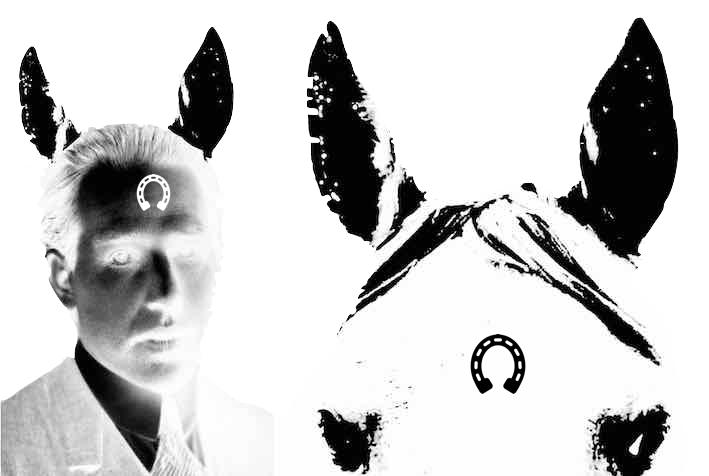
リンク
文献
その他の情報
Copyleft, CC, Mitzub'ixi Quq Chi'j, 1996-2099
Do not paste, but [Re]Think our message for all undergraduate students!!!
+++
Copyleft, CC, Mitzub'ixi Quq Chi'j, 1996-2099
☆
 ☆
☆